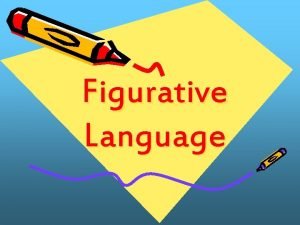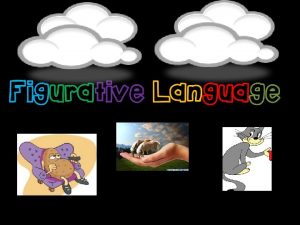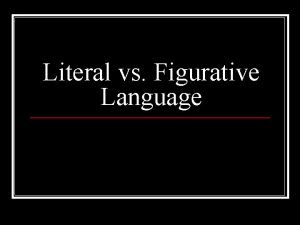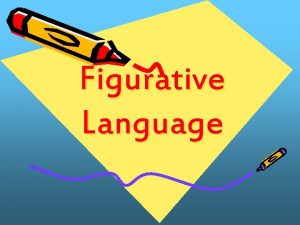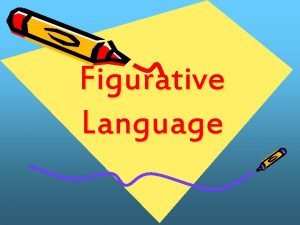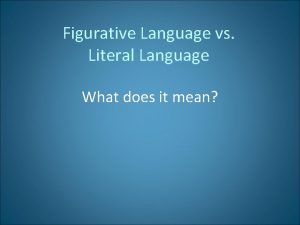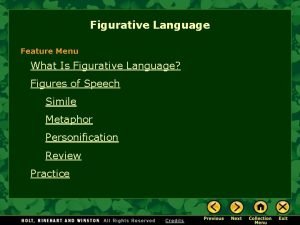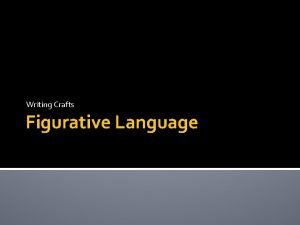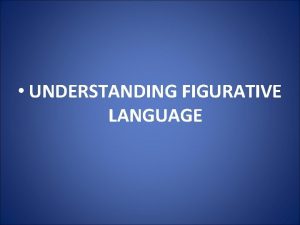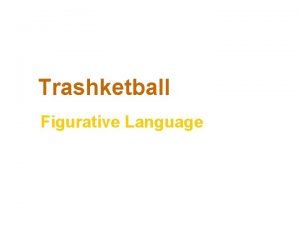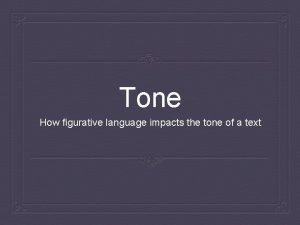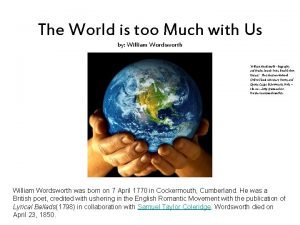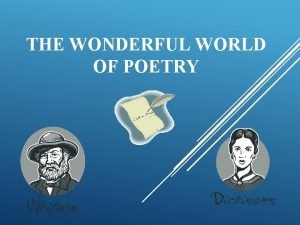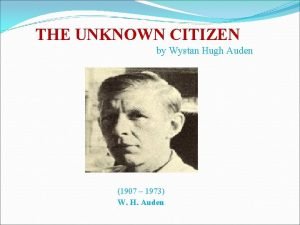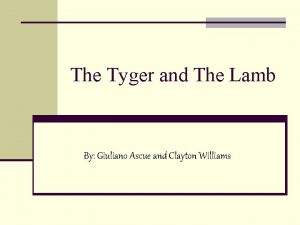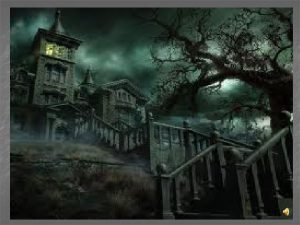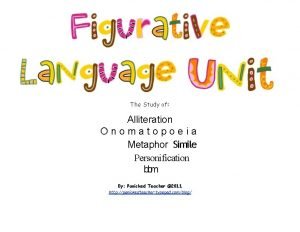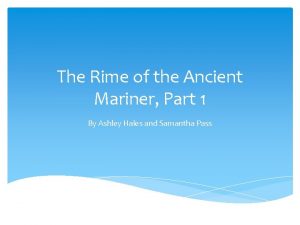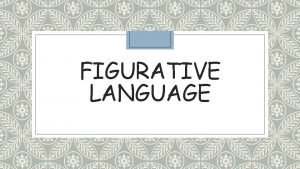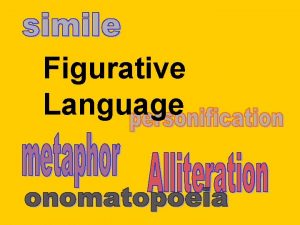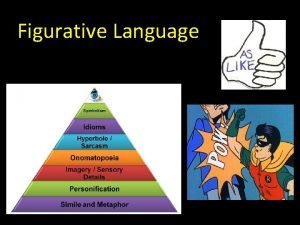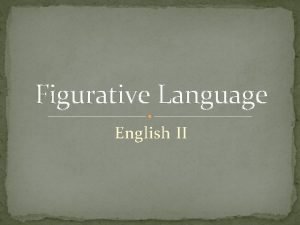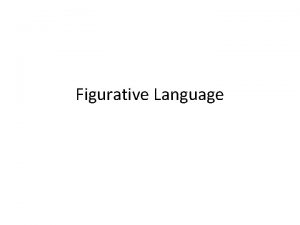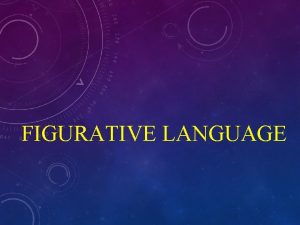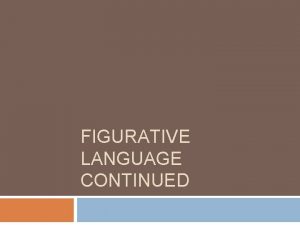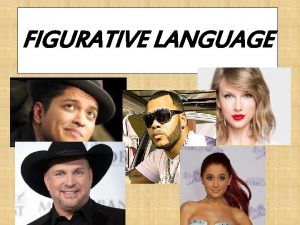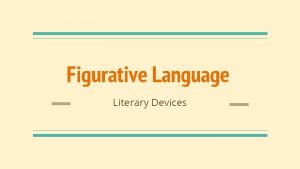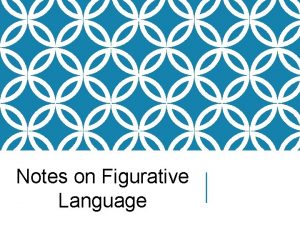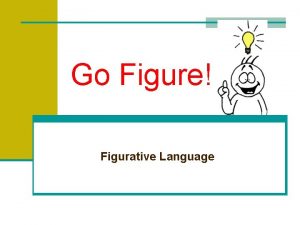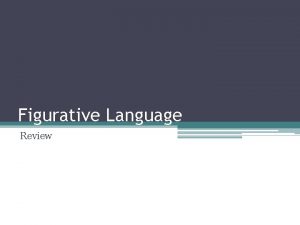FIGURATIVE LANGUAGE Figurative Language n What is figurative




















- Slides: 20

FIGURATIVE LANGUAGE

Figurative Language n What is figurative language? n How can I interpret figurative language?

What is figurative language? n Whenever you describe something by comparing it with something else, you are using figurative language.

Figurative Language Here are some examples. What do you think figurative language means? n The wind whispered softly through the trees. n The cafeteria pizza was a soggy, droopy piece of cardboard. n The teacher glared like a furious dragon.

Figurative Language The wind whispered through the trees Ca n win d rea lly whi sp er? Wh at is the aut hor tryi n Can wind really whisper? n What is the author trying to tell us about wind?

What is figurative language? The teacher glared like a furious dragon. n Was the teacher really a dragon? n What is the author trying to tell us about the teacher?

Types of Figurative Language n Simile n Metaphor n Personification n Hyperbole n Onomatopoeia n Alliteration n Imagery n Idioms

Simile n A simile is a direct comparison between two unlike objects, usually with the words “like” or “as”. n Example: The muscles on his brawny arms are strong as iron bands. n Example: The students sat down at the cafeteria table and ate like pigs. n What is being compared?

Metaphor n A metaphor is a figure of speech which involves a comparison between two unlike things without using “like” or “as”. n Example: The road was a ribbon wrapped through the desert. n Example: The school was a maze of hallways and passages.

How can I interpret figurative language? Metaphor • The school was a maze of hallways and passages • What idea is the author trying to express with this metaphor?

Personification n A figure of speech which gives the qualities of a person to an animal, an object, or an idea. n Example: “The wind yells while blowing. " The wind cannot yell. Only a living thing can yell. n Example: The leaves danced as they fell from the trees. What are the leaves doing that leaves can’t really do?

How can I interpret figurative language? The leaves danced as they fell from the trees. n That’s right! Leaves can’t dance n This is an example of personification n What is the author trying to tell us about the leaves?

“I Can” Checkpoint Can you answer these questions? n What is figurative language? n How can I interpret figurative language?

Hyperbole n An exaggerated statement used to heighten effect. It is not used to mislead the reader, but to emphasize a point. Example: She’s said so on several million occasions.

Onomatopoeia n The use of words that mimic sounds. Example: The firecracker made a loud ka-boom!

Alliteration n Repeated consonant sounds occurring at the beginning of words or within words. Example: She was wide-eyed and wondering while she waited for Walter to waken.

Imagery n Language that appeals to the senses. Descriptions of people or objects stated in terms of our senses. • Sight • Hearing • Touch • Taste • Smell

Idioms n An idiom refers to an expression in one language that cannot be matched or directly translated word-for-word in another language. Example: "She has a bee in her bonnet, " meaning "she is obsessed, " cannot be literally translated into another language word for word.

Figurative Language Resources Eye on Idioms (Online PPT) Paint by Idioms (Game) Alliteration or Simile? (Quiz) Similes and Metaphors (PPT) The Search for Similes, Metaphors, and Idioms (PPT) n Alliteration (PPT) n Onomatopoeia (PPT) n Personification (PPT) n Hyperbole (PPT) n Idioms (PPT) n Simile (PPT) n n n

Teaching Similes and Metaphors n Alliteration Lesson Plan and Resources n n n n http: //volweb. utk. edu/Schools/bedford/harrisms/1 allitera. htm Hyperbole- Lesson Plans and Resources http: //volweb. utk. edu/Schools/bedford/harrisms/10 lesson. htm Idiom Lesson Plan http: //volweb. utk. edu/Schools/bedford/harrisms/6 lesson. htm Imagery- Lesson Plans and Resources http: //volweb. utk. edu/Schools/bedford/harrisms/imagery 2. htm Lesson Plan for Puns http: //volweb. utk. edu/Schools/bedford/harrisms/5 lesson. htm Onomatopoeia- Lesson Plans and Resources http: //volweb. utk. edu/Schools/bedford/harrisms/9 lesson. htm Personification Lesson Plans and Resources http: //volweb. utk. edu/Schools/bedford/harrisms/7 lesson. htm Proverbs- Lesson Plans and Resources http: //volweb. utk. edu/Schools/bedford/harrisms/proverbs 2. htm
 Literal and figurative language
Literal and figurative language Figurative language is language that
Figurative language is language that Phones blowing up figurative language
Phones blowing up figurative language Litteral language
Litteral language Literal and figurative language quiz
Literal and figurative language quiz Figurative language vs literal language
Figurative language vs literal language Is figurative language a language feature
Is figurative language a language feature Repetition in night by elie wiesel
Repetition in night by elie wiesel Personification examples winter
Personification examples winter Language
Language Ellipsis figurative language
Ellipsis figurative language Who is the author
Who is the author Trashketball directions
Trashketball directions Is tone a figurative language
Is tone a figurative language The world is too much with us is a sonnet
The world is too much with us is a sonnet A formal division of lines in a poem
A formal division of lines in a poem The unknown citizen poetic devices
The unknown citizen poetic devices Little lamb figurative language
Little lamb figurative language The tell tale heart summary question answer
The tell tale heart summary question answer Betsy bought bigger bottoms for baby billy
Betsy bought bigger bottoms for baby billy Summary of the rime of the ancient mariner part 1
Summary of the rime of the ancient mariner part 1
